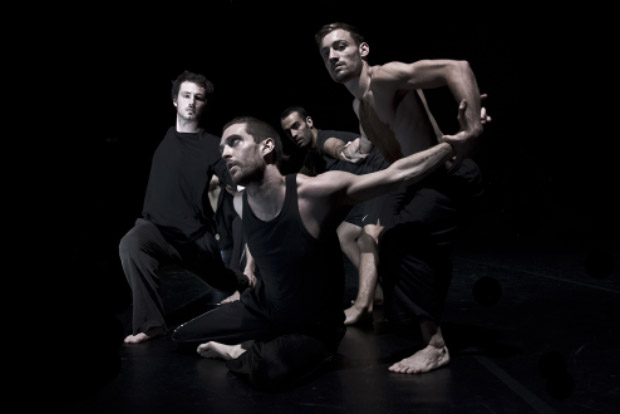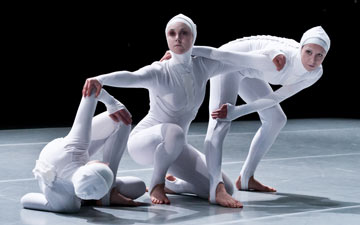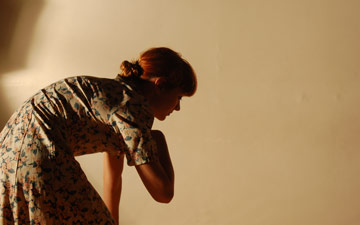
© Riccardo Buscarini.
Riccardo Buscarini
No Lander
London, The Place
28 October 2015
www.riccardobuscarini.com
Imagine a pinhole camera, the length of a pipeline, snaking and squeezing its way through the crevices, cracks, channels and chasms on a journey to the world’s deepest pothole, in which cavernous bunker the lens comes upon five men: stranded in the dark, lost in melancholy; without light; without hope; without land.
This dark imagery was inspired by the opening of Riccardo Buscarini’s imaginatively-entitled No Lander; the performance beginning in a role-reversal of the house lights up and the stage dark, while a human shape wriggled under the dance floor, creating eerie squeaking noises to punctuate the silence. When, eventually, lights dimly illuminate the stage, Domenico Angarano’s soundscape begins. It soon becomes apparent that a dominating influence of the sound is broadcast from microphones around the stage, picking up the noises of the dancers’ interaction with the floor and each other.
Buscarini won the 2013 Place Prize with his slow-moving, sinuous and stylish Athletes, made for three women. The resonant image in that work came from their stark, white, alien “onesies”, body-covering unitards with a protruding spine. Here, the costuming was a mix of drab, grey/black casual clothes (vests, short, t-shirts etc) but the theatrical impact was no less astonishing, enhanced and emphasised by Michael Mannion’s lighting designs and the choreographer’s emphasis on a robust style ethos (created in collaboration with Annette Malone). Visually, No Lander could hardly be more different from Athletes; but the slow, deliberate approach to movement and style was very clearly from the same creative mould.
My initial idea of caving was wrong. Buscarini’s inspiration for No Lander arose from his classical studies and specifically from the themes of Homer’s Odyssey. The five men are not lost in a pothole but represent marooned sailors, missing at sea or castaways on an island. They are in peril; defenceless and vulnerable in a vast and treacherous void. Their journey, from beneath the dance floor, perhaps as a metaphor for the waves, takes in many shapes and images. I fancied that one guy wobbled in diverse ripples, maybe like a jellyfish; two men lie comatose while three others run through a playground game; the five guys use each others’ bodies to cross space; the whole group skips in unison; but two of them later try to claw the flesh from each other. Twisting, torsional, often floor-based movements are dominant motifs.
Watery, rickety sounds plop and click in the background while the group dynamic sees alliances form while one guy appears isolated in a melancholic solo. The sense of belonging to the group, a mutual protection from unseen threats, is replaced by the fear of segregation, of being left alone in this intimidating landscape. The prologue is book-ended by an epilogue that sees dancers return beneath the dance floor; as if falling into the dark, pitiless void.
Viewing this fight for life for an uninterrupted hour is a challenge but one worth the sustained effort in concentration. I was absorbed in Buscarini’s coded, episodic depiction of humanity’s struggle for survival. The dancers were deliberately anonymous but excellently co-ordinated into a coherent quintet, whether articulating the group sense of belonging by performing as a single organism (at one point their unified shaping reminded me of a salamander, or some form of sea monster) or the melancholy of isolation, the fear of falling into the void.
This is a work – like Athletes before it – that eschews narrative detail to achieve a level of theatrical artistry that cannot be adequately described as dance. It is intelligent performance art of a very high quality.

















You must be logged in to post a comment.